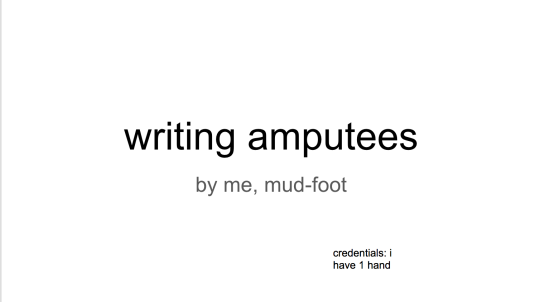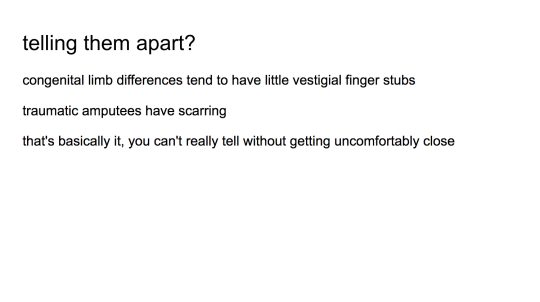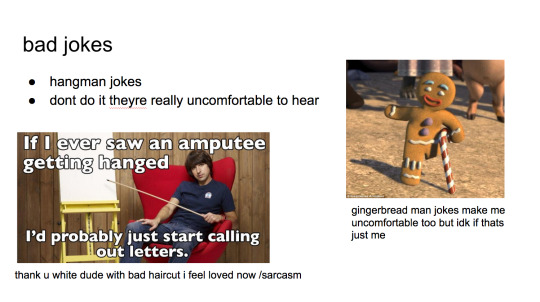Text
The Four Act Story Structure (with Black Panther)
Part 1 - Orphan
Narrative Context: Set Up the story. In the first 20% - 25% of your novel, you will: Introduce the character (backstory, their stasis, their inner demons, their strengths), establish stakes (what the character has to lose), foreshadow the imminent conflict to come.
Hook: The hook happens in the first chapter of your novel, the earlier the better. It grabs the reader, makes us empathize with the protagonist, and gives the reader something to bite into before the protag’s quest really begins.
Example: (Black Panther) Freeing kidnapped women from warlords to call Nakia back to Wakanda.
Inciting Incident: Something happens to your character that incites the coming conflicts. This could happen as early as the hook, or could happen as late as Plot Point 1.
Example: Klaw and Killmonger steal vibranium from a British museum.
Plot Point 1: At 20% or 25% in your novel, something big happens that alters the protag’s plans/status/beliefs, forcing them to respond. The first plot point defines the nature of the hero’s quest, and everything you’ve set up (stakes, inner demons, foreshadowing) has led up to this point. Imagine the first quarter of the novel as pulling back the plunger in a pinball machine, and the first plot point is when you let the ball fly. The antagonist is introduced, but their true nature will not be fully revealed until the midpoint.
Example for Plot Point 1 from Black Panther: ~35m/123m (28%), Klaw’s whereabouts are known. T’Challa needs to go on a retrieval mission, putting his leadership as King to test for the first time.
Part 2 - Wanderer
Narrative Context: Reaction. 25% - 50% of your story. Something big has just happened (Plot Point 1) and the protagonist is reacting to it, running from it, pursuing it without knowing what it is. There is a sense of indecision, or lack of knowledge. We don’t have all the answers.
Example: T’Challa, Nakia, and Okoye are after Klaw, but they haven’t been fully introduced to the true antagonist, Killmonger.
Pinch Point 1: The first Pinch Point comes in the middle of Part 1. A pinch point is a big moment that reminds the reader of the power of the antagonist.
Example: 59/123 min, 47%. Right when the gang thinks they’ve got Klaw, he escapes with the help of Killmonger. T’Challa sees Killmonger for the first time, taking notice of the ring he wears. Who is this man? T’Challa realises he doesn’t have all the answers, that there’s something bigger going on.
Midpoint: One of the biggest points in the story, and a huge plot twist that reveals the true nature of the antagonist. It is like a veil is lifted, and the character sees more clearly what they’re up against, on an external, internal, and thematic level.
Example of the Midpoint: In Black Panther, the midpoint happens from 63 min - 67 min (~52%) in two scenes. First, we get a big plot twist. Killmonger reveals that he is of Wakandan blood, and that he’s going to the hidden nation. He kills Klaw and even his own girlfriend without hesitation. This lets the viewer know Killmonger’s goals and the danger he poses as an antagonist. In the second scene of the Midpoint, Zuri reveals what really happened to T’Challa’s uncle (and Killmonger’s father): he was killed by T’Chaka, leaving Killmonger fatherless. T’Challa realises that he’s going to have to pay the consequences for his father’s mistakes, and truly questions for the first time whether Wakanda’s tradition of secrecy is moral.
Part 3 - Warrior
Narrative Context: Action. 50% -75/80% of your story. Again, something game changing has just happened (the midpoint), which suddenly clarifies the nature of the antagonistic force. With this new insight, the protagonist is able to go on attack mode, actively trying to solve the issue at hand.
Example: Now that Killmonger has made himself known as the true antagonist, T’Challa has to face him and the mistakes T’Chaka made in the past.
Pinch Point 2: The second pinch point occurs halfway through the third quarter. Like the first pinch point, it is a reminder of the threat of the antagonistic force.
Example: 81 min - 82 min in Black Panther, or 66% into the story, Killmonger overthrows T’Challa.
Plot Point 2: The second plot point happens around 75% or 80% into the novel. It may be a characters realisation of what they must do to defeat the antagonist or a piece of information that allows them to face the bad guy. Whatever it is, no new information may be introduced after this point unless it is heavily foreshadowed. This is to prevent a deux ex machina.
Example: (98 min, 80%) T’Challa speaks to his forebears and realises that their actions were immoral. He says, “I must take the mantle back” and regains his power as black panther. He is ready to face Killmonger, and there is a sense that he now has a chance of defeating him.
Part 4 - Martyr
Narrative Context: Martyr. 75/80% - 100% of your story. This is the final battle, the end game. Often in a self-sacrificial way, the protagonist faces the big baddies and defeats them one by one. They are heroic, they are active, and they defeat the antagonist by their own strength.
Example: T’Challa and his crew face Killmonger to stop him from sending Wakandan weaponry to other countries. Notice that each character, T’Challa, Shuri, Okoye, Nakia, and Ross do something heroic and self-sacrificing. Occasionally something comes in that turns the tides in the heroes’ favour (this must be heavily foreshadowed) like when M’Baku decides to join sides with T’Challa.
Climax: Close to the end, midway in Part 4, the antagonist is defeated and the theme is clearly splayed out.
In Black Panther, this happens at 115 min - 118 min (or 94%) when T’Challa brings Killmonger out of the vibranium mines to see the Wakandan sunset. Killmonger chooses to die rather than live in bondage. After this point, we switch to the resolution.
Resolution Scene: Everything is wrapped up after the climax. This isn’t necessarily one scene, but can be many. May be one chapter or several depending on how many plot threads need to be tied up. Whatever happens, we enter into a new stasis and see the effect of the protagonist’s journey both physically (how the world changes around them) and psychologically (how they have changed internally).
Example: In Black Panther, we find out that T’Challa has decided to make an outreach program for African-American youth. He learns from Killmonger and decides to use Wakandan technology and resources so that the future generation does not suffer like Killmonger did.
How to use the Four Act Story Structure
On a practical level, how can writers use the Four Act Structure? I would recommend using it both in reading and in writing:
When reading or watching a movie, look out for the major plot points and act breaks. Have you ever felt that a story feels unbalanced? Rushed in parts? It is likely because it does not follow the Four Act Structure.
You can also use this structure in outlining. It will prevent you from going, “What the hell is going to happen next?” and will help you create a story that is well structured. Another reason I like this structure is because it details how to plot the middle portion of a novel.
However, keep in mind that movies are paced differently than books, and that even all books aren’t paced the same. You will not die in writers hell if you don’t follow this structure exactly. Rather, it is good to understand why this structure works so that you can better structure your own novels. For instance, Harry Potter and the Philosopher’s Stone does not follow this structure like I’ve laid out (though many argue that the first book is unbalanced; Harry doesn’t get to Hogwarts until 40% into the book.)
If you’d like to read more in depth about the Four Act Structure, Larry Brooks writes about it in Story Engineering. But a word of warning: Brooks does seem to believe that you will die in writing hell if you don’t follow this structure, and he hates pantsers with a passion. It’s still an informative read, but please take everything he says with a grain of salt.
801 notes
·
View notes
Photo


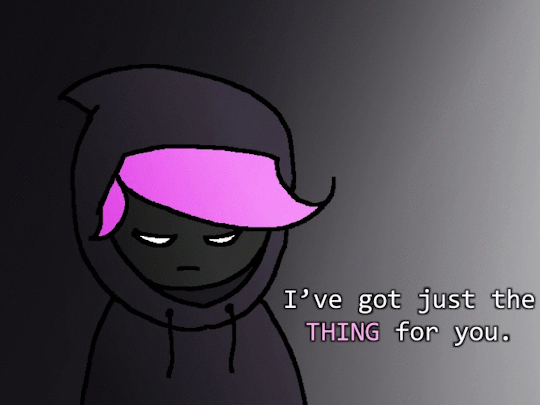
So, let me guess– you just started a new book, right? And you’re stumped. You have no idea how much an AK47 goes for nowadays. I get ya, cousin. Tough world we live in. A writer’s gotta know, but them NSA hounds are after ya 24/7. I know, cousin, I know. If there was only a way to find out all of this rather edgy information without getting yourself in trouble…
You’re in luck, cousin. I have just the thing for ya.
It’s called Havocscope. It’s got information and prices for all sorts of edgy information. Ever wondered how much cocaine costs by the gram, or how much a kidney sells for, or (worst of all) how much it costs to hire an assassin?
I got your back, cousin. Just head over to Havocscope.
((PS: In case you’re wondering, Havocscope is a database full of information regarding the criminal underworld. The information you will find there has been taken from newspapers and police reports. It’s perfectly legal, no need to worry about the NSA hounds, cousin ;p))
Want more writerly content? Follow maxkirin.tumblr.com!
419K notes
·
View notes
Text
Editing tip: Are you suffering from -ing disease?
Hey all! Another tip from the editor’s desk. This one is about verbs that end in -ing.
In fiction, -ing verbs can be accurately used to:
(1) Indicate that two actions are happening simultaneously.
Example: While running to catch the bus, Jake dropped his keys.
(2) Show that an action is ongoing or still in progress.
Example: Ingrid wanted to use the oven for her pot roast, but the muffins were still baking.
Jason had been attending college for three years.
But when you misuse or overuse -ing verbs, it quickly becomes tedious and awkward for readers.
As an editor, here are the most common mistakes I see beginning fiction writers make with -ing verbs:
Keep reading
3K notes
·
View notes
Text
Common Occupations in the Middle Ages
Almoners: ensured the poor received alms.
Atilliator: skilled castle worker who made crossbows.
Baliff: in charge of allotting jobs to the peasants, building repair, and repair of tools used by the peasants.
Barber: someone who cut hair. Also served as dentists, surgeons and blood-letters.
Blacksmith: forged and sharpened tools and weapons, beat out dents in armor, made hinges for doors, and window grills. Also referred to as Smiths.
Bottler: in charge of the buttery or bottlery.
Butler: cared for the cellar and was in charge of large butts and little butts (bottles) of wine and beer. Under him a staff of people might consist of brewers, tapsters, cellarers, dispensers, cupbearers and dapifer.
Carder: someone who brushed cloth during its manufacture.
Carpenter: built flooring, roofing, siege engines, furniture, panelling for rooms, and scaffoling for building.
Carters: workmen who brought wood and stone to the site of a castle under construction.
Castellan: resident owner or person in charge of a castle (custodian).
Chamberlain: responsible for the great chamber and for the personal finances of the castellan.
Chaplain: provided spirtual welfare for laborers and the castle garrison. The duties might also include supervising building operations, clerk, and keeping accounts. He also tended to the chapel.
Clerk: a person who checked material costs, wages, and kept accounts.
Constable: a person who took care (the governor or warden) of a castle in the absence of the owner. This was sometimes bestowed upon a great baron as an honor and some royal castles had hereditary constables.
Cook: roasted, broiled, and baked food in the fireplaces and ovens.
Cottars: the lowest of the peasantry. Worked as swine-herds, prison guards, and did odd jobs.
Ditcher: worker who dug moats, vaults, foundations and mines.
Dyer: someone who dyed cloth in huge heated vats during its manufacture.
Ewerer: worker who brought and heated water for the nobles.
Falconer: highly skilled expert responsible for the care and training of hawks for the sport of falconry.
Fuller: worker who shrinks & thickens cloth fibers through wetting & beating the material.
Glaziers: a person who cut and shaped glass.
Gong Farmer: a latrine pit emptier.
Hayward: someone who tended the hedges.
Herald: knights assistant and an expert advisor on heraldry.
Keeper of the Wardrobe: in charge of the tailors and laundress.
Knight: a professional soldier. This was achieved only after long and arduous training which began in infancy.
Laird: minor baron or small landlord.
Marshal: officer in charge of a household’s horses, carts, wagons, and containers. His staff included farriers, grooms, carters, smiths and clerks. He also oversaw the transporting of goods.
Master Mason: responsible for the designing and overseeing the building of a structure.
Messengers: servants of the lord who carried receipts, letters, and commodities.
Miner: skilled professional who dug tunnels for the purpose of undermining a castle.
Minstrels: part of of the castle staff who provided entertainment in the form of singing and playing musical instruments.
Porter: took care of the doors (janitor), particularly the main entrance. Responsible for the guardrooms. The person also insured that no one entered or left the castle withour permission. Also known as the door-ward.
Reeve: supervised the work on lord’s property. He checked that everyone began and stopped work on time, and insured nothing was stolen. Senior officer of a borough.
Sapper: an unskilled person who dug a mine or approach tunnel.
Scullions: responsible for washing and cleaning in the kitchen.
Shearmen: a person who trimmed the cloth during its manufacture.
Shoemaker: a craftsman who made shoes. Known also as Cordwainers.
Spinster: a name given to a woman who earned her living spinning yarn. Later this was expanded and any unmarried woman was called a spinster.
Steward: took care of the estate and domestic administration. Supervised the household and events in the great hall. Also referred to as a Seneschal.
Squire: attained at the age of 14 while training as a knight. He would be assigned to a knight to carry and care for the weapons and horse.
Watchmen: an official at the castle responsible for security. Assited by lookouts (the garrison).
Weaver: someone who cleaned and compacted cloth, in association with the Walker and Fuller.
Woodworkers: tradesmen called Board-hewers who worked in the forest, producing joists and beams.
Other medieval jobs included:
tanners, soap makers, cask makers, cloth makers, candle makers (chandlers), gold and silver smiths, laundresses, bakers, grooms, pages, huntsmen, doctors, painters, plasterers, and painters, potters, brick and tile makers, glass makers, shipwrights, sailors, butchers, fishmongers, farmers, herdsmen, millers, the clergy, parish priests, members of the monastic orders, innkeepers, roadmenders, woodwards (for the forests). slingers. Other Domestic jobs inside the castle or manor:
Personal atendants- ladies-in-waiting, chamber maids, doctor.
The myriad of people involved in the preparation and serving of meals- brewers, poulterer, fruiterers, slaughterers, dispensers, cooks and the cupbearers.
By Lise Hull READ MORE
49K notes
·
View notes
Text
Best Spotify Writing Playlists
Having trouble getting in the zone to write the perfect scene? Skip searching and start writing!

Adventure/Epic:
Epic Celtic
Epic Battle
Epic Orchestra
White Noise:
Getting Work Done
Soundtrack for Study
Instrumental Pop/Cinema:
Acoustic Calm
Cinematic Chillout
Romance:
Love Pop
Move On & Don’t Look Back
Ethereal Romance
Love Songs
Upbeat Energy:
Good Vibes
Get Happy
3K notes
·
View notes
Text
Types of Stupid Characters
it is commonly known that there are different types of intelligence, and it should follow that there are different types of stupidity, but this fact seems less well-known. anyway, here is a resource for crafting your himbos and regular dumbasses
classic book smart but no common/practical sense: this is the character that speaks 8 languages or has multiple phds or is a pioneer in their field but can’t cook mac and cheese from a box or be trusted with a weed whacker. as the title says, a classic, very valid.
book smart, may have practical sense, but Does It Anyway: This is the character constantly asking, “What happens if...” The answer is usually swearing and property damage.
wise but classically stupid: this character will hit you with deep wisdom and advice about life but then will ask you how many legs a duck has . Underutilized and underrated.
wise but can’t take their own advice: This character will give you profound advice about life and then end up falling-down drunk in a ditch in florida covered in alligator bite marks and sobbing about their ex. They’re completely levelheaded when advising other people but all their personal decisions are just the worst
competent at exactly one thing: self explanatory.
good-hearted and well intentioned, but socially clueless: will tell their girlfriend that her dress makes her look rectangular, and be confused why this isn’t taken as a compliment, and then buy her a chameleon to make up because women like chameleons, right
practical sense but can’t read the room: levelheaded and good at whatever it is that they do, but not good at being diplomatic. will call you an idiot to your face if you question their practical know-how no matter how important you are.
not actually lacking in cleverness or sense, but no impulse control: thoughts take longer to load than actions for this character. hindsight is 20/20, but it’s hind instead of fore
lovable and socially intelligent but completely stupid otherwise: this character is cute, charismatic or socially adept enough to make it just about anywhere. It takes a private, informal conversation for people to realize that there’s nothing going on upstairs
smart maybe 30% of the time: it’s a total crap shoot whether this character’s thoughts and ideas are brilliant or terrible. They sometimes come up with something great, often enough for them to be thought of as a genius, but a lot of the time there’s nothing in their head but bullshit
15K notes
·
View notes
Text

New blog post on ellaholmes.com!
This week I collaborated with the amazing @cogesque to talk about how you can use Tumblr as a writer.
We covered topics such as:
What it means to be a ‘writerblr’
Some things you can do to get started as a writer on Tumblr
How you can share your work on Tumblr
How you can start putting yourself ‘out there’!
What we like about using Tumblr as a writing platform
Blog themes
Whether you’re new to writerblr, or a veteran blogger, there may be some handy hints in here for you!

Click here to view the blog post, or use the link at the top of this post!
You can find @cogesque on Twitter and on their website.
You can find me here, on Twitter and on my website.
Got any more questions? Leave them in the comment section of the blog post, and I’ll be sure to do the best I can in answering them. 😊
And, as always, if you enjoyed the post please consider reblogging this post, or sharing it directly from my blog! Thank you!
80 notes
·
View notes
Text
HEY ARTISTS!
Do you design a lot of characters living in not-modern eras and you’re tired of combing through google for the perfect outfit references? Well I got good news for you kiddo, this website has you covered! Originally @modmad made a post about it, but her link stopped working and I managed to fix it, so here’s a new post. Basically, this is a costume rental website for plays and stage shows and what not, they have outfits for several different decades from medieval to the 1980s. LOOK AT THIS SELECTION:

OPEN ANY CATEGORY AND OH LORDY–

There’s a lot of really specific stuff in here, I design a lot of 1930s characters for my ask blog and with more chapters on the way for the game it belongs to I’m gonna be designing more, and this website is going to be an invaluable reference. I hope this can be useful to my other fellow artists as well! :)
296K notes
·
View notes
Text
Mood
Me everyday: I’m gonna finish this piece and get started on the next. No distractions, just me and my writing.
Me two hours later:

89 notes
·
View notes
Photo

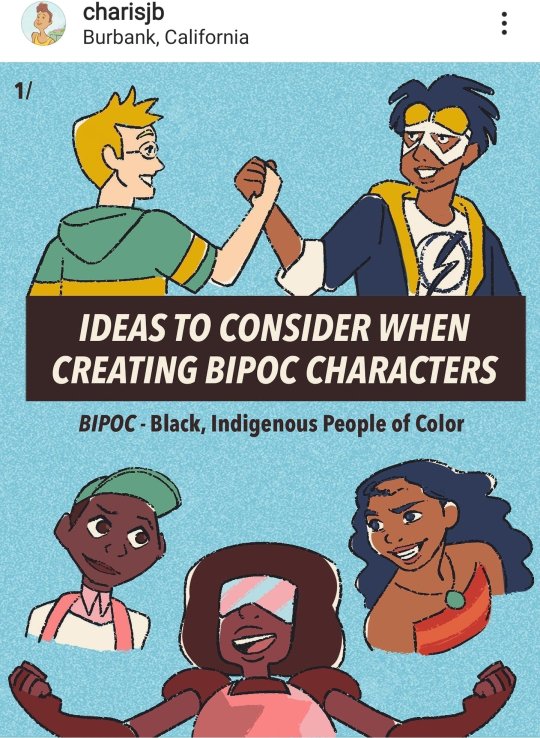
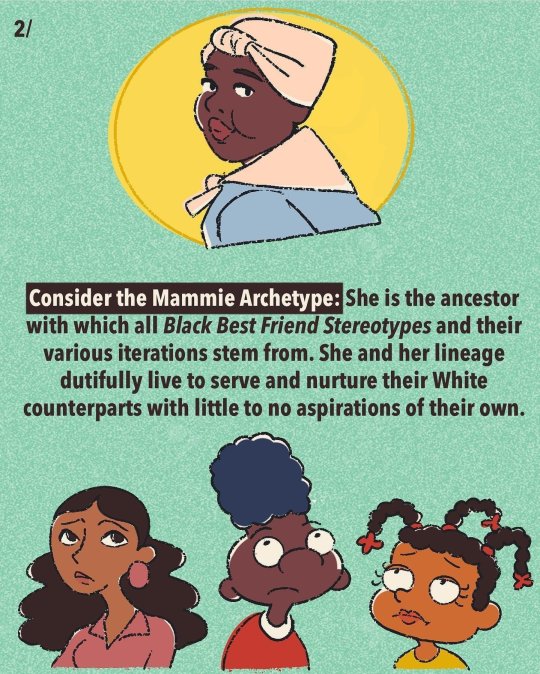

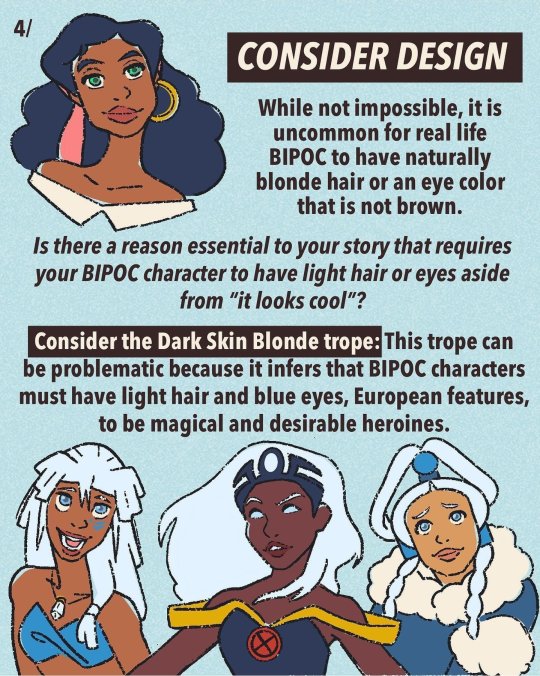
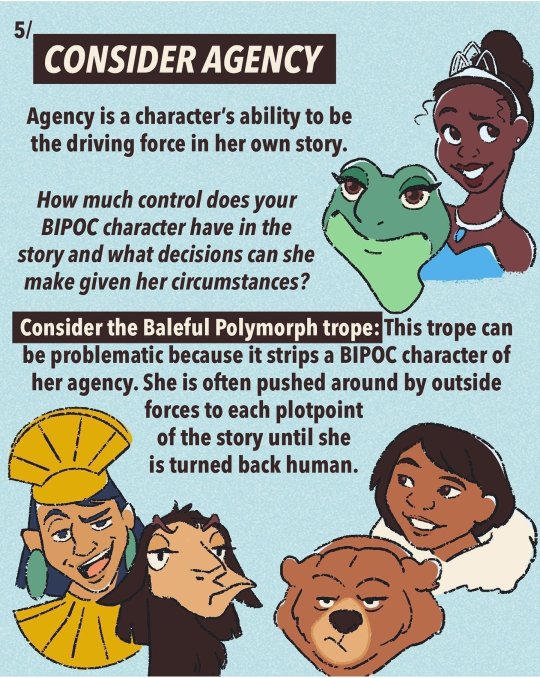

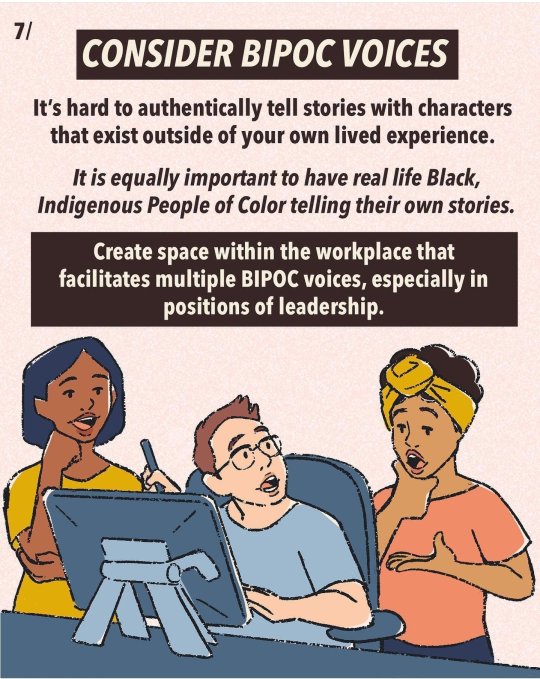
Important ideas to consider when creating characters who are black and indigenous people of color. (x)
185K notes
·
View notes
Text
Writing with multiple POVs
Alright guys, it’s time I got in here with my own personal opinions and takes on writing, and first up: multiple POVs
I’ve seen a lot of posts discussing POVs and honestly, it kind of surprised me how so many of them have said that one POV is enough, two or three if you really must for plot purpose, but more than that is too many.
Bullshit
Of course, like all things in writing, multiple POVs can be majorly fucked up, or be an amazing asset to a story. So…. As someone who specializes in writing stories with a lot of POVs, here are my personal tips for making it work
1. Know your characters
First and foremost, know your characters before you begin writing. Know them inside and out. Know their darkest fear, their worst flaw, their motivations, their favorite food, if they’d rob a bank on a dare, everything. This is pretty standard for all writing, but especially in multiple POVs.
Here’s why:
If you write single POVs (or even just two or three), you might be able to get away with beginning your story without having your character 100% fleshed out. But if you do this in multiple POV writing, all your characters will sound and act exactly the same by the end of it.
You probably won’t even notice it’s happening at first, until you reach a pivotal scene (especially one dealing with characters’ emotional responses) and you find that they all respond the same way. This happened to me when I first began writing, but it can be easily avoided if you just make sure you know your characters better than you know yourself before you begin writing.
2. Character Diversity
This goes hand in hand with knowing your characters. I don’t want to read a POV and then supposedly go to a completely different one, but the second character has the same exact motivations, personality, and thought processes as the first character. If one character is a brash, outspoken, spunky servant girl, make a timid, thoughtful princess who just wants out of the spotlight, and then her best friend, the stable boy who’s a secret magic user and uses his abilities for practical jokes and just enjoys his life, etc. Make them different! It’s incredibly boring to read the exact same thing, over and over again.
Of course, all your characters will probably have at least some similarities I mean, if not, why would they even be together? This is okay, and even good for interactions between them, just make sure that their similarities are in balance with their differences and that one doesn’t overshadow the other.
3. Who is narrating what and when?
From the beginning, know who is going to narrate what and when. Because remember, even if your characters are always together, they’re all going to narrate the same scene in a different way. So… before you begin a scene, think about which character is going to put the best spin on it and be the most logical to narrate it. Examples: If you are going to write an intense battle scene, you will most likely want a character narrating from the thick of battle, and one who knows battle well. You don’t want the princess who is sitting in the palace, simply waiting on news from the battlefield to narrate the entire window of time that the battle is taking place in. Not to say she can’t narrate at all during the battle, just not all of it.
Also, you will want to know exactly how much of your WIP your characters are each narrating. Personally, I divide it up evenly. For my Legends series, each of the books is thirty-two chapters, and each of my eight narrators narrates four chapters. But this doesn’t have to be the case. You may have one character who narrates half the novel, while the other five characters only narrate a fifth. This, of course, is fine. Just make sure you have carefully planned out when everyone is going to narrate before you begin.
4. Balancing narrating MCs with MCs that don’t have a narrating role
This one can be kind of difficult. If you have multiple POVs, it may start to feel like the only way a character can be a main character is if they narrate as well. They feel overshadowed by narrating characters.
Honestly, the only way to avoid this is to make sure they get a ton of page time. Put them in every scene that is pivotal to the plot and make sure they have a strong relationship with at least one of the narrators. If you do this, there’s really no way they could be overshadowed. And if it just feels awkward putting them in that many scenes or building relationships between them and the narrators, then they’re probably not meant to be a main character anyways.
5. Read books with multiple POVs
Yeah, yeah, most stereotypical writing advice ever. But really, this is extremely helpful. You can experience many different dynamics between characters and see various different techniques with multiple POVs. Not only that, but it’s proof that you can make it work if you do things right and that multiple POVs aren’t automatically a writing taboo.
Some examples (unfortunately, I almost exclusively read/write fantasy and sci/fi so that’s pretty much all I have to offer):
Six of Crows duology (Leigh Bardugo), Game of Thrones (George R. R. Martin), The Lunar Chronicles (Marrissa Meyer), Heroes of Olympus series (Rick Riordan), Strange the Dreamer (Laini Taylor), Throne of Glass series (Sarah J. Maas)
6. Alright, really, though. How many POVs is too many POVs?
I mean, it has to be brought up, because logically and realistically, there is a point where there are too many POVs. For me, personally, the limit is ten (especially if the characters all narrate equally, not if there’s a random side character that narrates one scene for plot purposes). The most narrators I have for one series is nine, my average is six, and my lowest is three. Of course, if you want to go above ten, by all means go for it. Just remember, it’s going to be difficult for you to keep track of everything. Not only that, but you may begin to shrink the audience interested in your books, because it can be difficult for a reader to keep up with that many POVs and complexity. It will become very niche (not that this is a bad thing, but if your goal is to have a large audience, I’m just saying that’s probably not the best idea you could have). So yes, in general, I would limit yourself to ten POVs.
Of course, like all writing advice, this is completely optional and if it doesn’t sound right to you, ignore it and do whatever the fuck you want. But I feel these are some fairly general guidelines for writing with multiple POVs.
3K notes
·
View notes
Photo

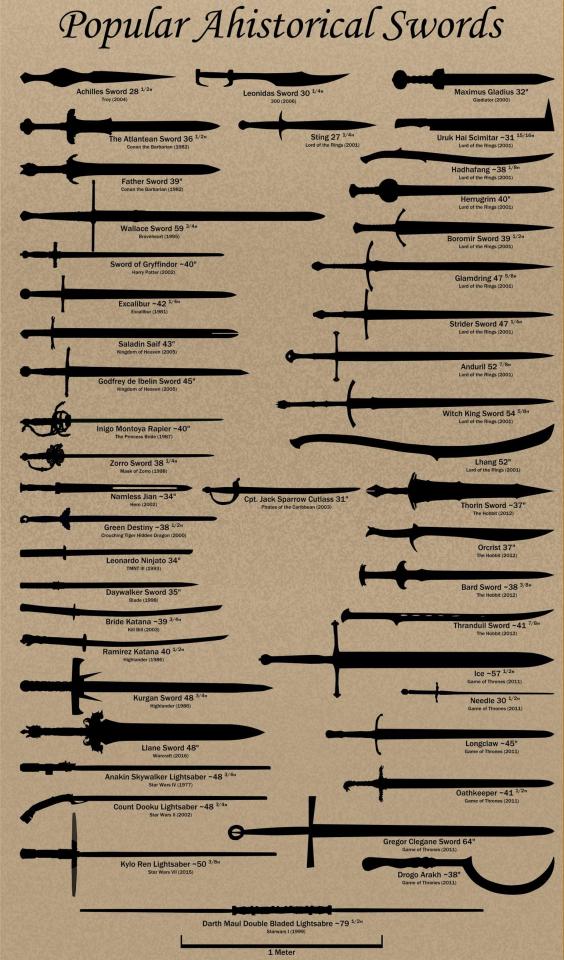
Popular Historical Swords and Popular Fictional Swords, by u/Dlatrex
40K notes
·
View notes
Text
5 frustrating workshop rules that made me a better writer
Throughout the 15 workshops I joined in college and grad school, I encountered two types of writing rules.
First, there were the best-practice guidelines we’ve all heard, like “show don’t tell.” And then there were workshop rules, which the professor put in place not because they’re universal, but because they help you grow within the context of the workshop.
My college’s intro writing course had 5 such rules:
No fantasy, supernatural, or sci-fi elements.
No guns.
No characters crying.
No conflict resolution through deus ex machina.
No deaths.
When I first saw the rules, I was baffled. They felt weirdly specific, and a bit unfair. But when our professor, Vinny, explained their purpose (and assured us he only wanted us to follow the rules during this intro workshop, not the others to come), I realized what I could learn from them.
1. No fantasy, supernatural, or sci-fi elements.
Writers need to be able to craft round characters, with clear arcs. While you can hone those skills writing any type of story, it can be more difficult when juggling fantastical elements, because it’s easy to get caught up in the world, or the magic, or the technology, and to make that the focus instead of the characters. So Vinny encouraged us to exclude such elements for the time being, to keep us fully focused on developing strong, dynamic characters.
2. No guns.
Weapons have a place in many stories, but when writers include a gun, they often use it to escalate the plot outside of the realm of personal experience and into what Vinny called “Hollywood experience.” He wanted us to learn how to draw from our own observations and perceptions of life, rather than the unrealistic action, violence, and drama we’d seen in movies, so he made this rule to keep us better grounded in our own experiences.
3. No characters crying.
When trying to depict sadness, writers often default to making characters cry. While there’s nothing inherently wrong with that, tears are just one way to show grief, and they aren’t always the most subtle or emotionally compelling. That’s why Vinny challenged us to find other ways to convey sadness — through little gestures, strained words, fragile interactions, and more. It was difficult, but opened us up to depicting whole new gradients of grief and pain.
4. No conflict resolution through deus ex machina.
This is the only one of the rules I’d say is generally universal. Meaning “God from the machine,” deus ex machina is a plot device where a character’s seemingly insurmountable problem is abruptly resolved by an outside force, rather than their own efforts. These endings are bad for various reasons, but Vinny discouraged them because he wanted us to understand how important it was for our characters to confront their struggle and its consequences.
5. No deaths.
Death is inherently dramatic and can be used to good effect, but many writers use death as a crutch to create drama and impact. Writers should be able to craft engaging, meaningful stories, even without killing off their characters, so this rule challenged us to find other methods of giving weight to our stories (such as through internal conflict).
How these rules helped me grow as a writer
First things first, I’ll say it again: apart from #4 (deus ex machina), these rules were never meant to be universally applied. Instead, their purpose was to create temporary barriers and challenges to help us develop key skills and write in new, unfamiliar ways.
For me, the experience was invaluable. I liked the way the rules challenged and stretched my abilities, driving me to write stories I’d have never otherwise attempted. They made me more flexible as a writer, and while I don’t follow the rules anymore (I LOVE me some fantasy), I’ll always be thankful for how they shaped my writing.
My recommendation to you?
Give some of these rules a shot! Follow them temporarily while writing 2-4 short stories — but remember to always keep their purpose in mind, because the rules themselves will only help if you understand what they’re trying to achieve.
Write with purpose, and you’ll always be growing.
— — —
For more tips on how to craft meaning, build character-driven plots, and grow as a writer, follow my blog.
11K notes
·
View notes
Text
200 Prompts
Not sure if they were deleted completely from this site, but I will be re-uploading all my prompt lists from my old writing blog onto here.
1. “You said that I’d get to have you all weekend. Why can’t you just tell them you can’t go?” - “Because it’s my job, and it’s important.” - “And I’m not?”
2. “You should sleep.” - “I’m not human, therefore, I do not require sleep.”
3. “I will protect you with my life.”
4. “Please don’t let me fall.” - “Never.”
5. “You’ll catch me, right?” - “Always.”
6. “You broke me and now you expect me to follow you out onto the battlefield? No. The answer is no.”
7. “I told you that I’d never leave you; I’m not going anywhere.”
8. “You take me instead, do you hear me? Give her back and take me instead.”
9. “Wait, something doesn’t feel right.”
10. “Did you hear that?”
11. “I almost just died and now you’re telling me that I’m a prophet of God? Are you sure you have the right person?”
12. “Stay here and don’t move. I’ll be right back.”
13. “Look, I know you’re a hardass, but can you play with my hair? It would really help.”
14. “I don’t deserve you.”
15. “Don’t tell me you’re fine, I can see the blood!”
16. “I’m sorry, but…I don’t remember you.”
17. “I wish I’d never met you.” - “No…you don’t mean that.”
18. “You know I hear you talking, but I still don’t have my coffee.”
19. “Do you want to know the hardest thing about having a soulmate? It’s not the separation in the beginning, not the endless nights lying awake, hoping and praying that someone was made for you. It’s…it’s the love. It’s too strong, and you can’t fight it. I’ve tried. Believe me, I’ve tried…but I’m always going to love you. And I need you to know that.”
20. “You would risk the lives of millions for one person? Why?” - “Because it’s not just one life…it’s yours.”
21. “This might sound selfish, but I don’t care about the world - I only care about you!”
22. “Was I just an easy scapegoat to you? Is that it?”
23. “No! Stay away from me! Stay back!”
24. “You must be mistaken - I don’t know who you are.”
25. “I need to know that you can trust me. Please.”
26. “I have these…powers raging around inside me, and I have no clue how to control them.”
27. “I need your help.”
28. “Take one more step and I snap her pretty little neck.”
29. “This is real. You’re real, I’m real. I need you to come back to reality.”
30. “You’re really starting to scare me.”
31. “I’m here for your protection.” - “I don’t need protecting.”
32. “Can someone please explain to me, in small words, why I’m being assigned to this mission?”
33. “Keep your hands over your ears, do you hear me? Even when the noises stop. Don’t listen.”
34. “Close your eyes and keep them closed.”
35. “You shouldn’t have seen that.”
36. “I don’t want you here.”
37. “Follow me. It’s okay, just hold my hand.”
38. “Whatever you do, don’t make a sound.”
39. “Stop freaking out, I’ll be right back.”
40. “That’s for me to know and for you to…well, you know how the saying goes.”
41. “I know the signs…you can’t hide from me, (Name).”
42. “It’s okay to break.” - “I’m not going to break.”
43. “Do you believe in soulmates?” - “No.” - “Oh, well that’s a shame because I’m it. I’m your soulmate.”
44. “If you’re watching this then that means I’ve been taken.”
45. “You can hold my hand if you want.”
46. “As long as I get to hold your hand.”
47. “I will always choose you.”
48. “I can braid your hair for you…if you’d like.”
49. “Maybe if you actually stop staring at her and talk to her, you might have a chance.”
50. “Are you drunk?” - “Not nearly enough.”
51. “Are you trying to seduce me?” - “Depends. Are you seducible?”
52. “I thought I almost lost you.”
53. “I’ve been calling you. I left voicemails - where were you?”
54. “You and me against the world, remember?”
55. “I’ll come back for you.”
56. “Do you remember this? It’s the music box you got me when we were twelve.”
57. “Never trust a man that can dance.”
58. “We’re not alone.”
59. “There’s someone in the house.”
60. “Pay attention to me.”
61. “Were you drawing me?”
62. “It’s basic human instinct.”
63. “I’d rather be spitting blood.”
64. “You can sleep now. I’ll fight the bad dreams off if they come to get you.”
65. “I didn’t tell you that I love you because I wanted to hear it back. I told you because I needed you to know.”
66. “It doesn’t matter what I want.”
67. “You can’t have her and it’s killing you inside.”
68. “Let’s carve our initials into the tree.”
69. “When you touch me I feel a little less broken.”
70. “You look so much like her…”
71. “Let me help you.”
72. “Come on. Let’s get you into the bath.”
73. “How many did you take? Open your mouth, I need to see.”
74. “You need medicine.”
75. “I need you to keep pressure on the wound, okay?”
76. “You have to promise me that you won’t fall in love with me.”
77. “You smell nice.”
78. “I could hear you screaming. Are you okay?”
79. “Shh. I heard something.”
80. “Stop staring at me like that.”
81. “I can never forget that taste.”
82. “I was made to destroy. Not to fix, but to break.”
83. “If you want me, come and get me, motherfuckers.”
84. “I see the spark in you. It’s amazing. Whatever you choose to do with it, you’ll be great.”
85. “If you need an emergency extraction just text SOS and I’ll send armed backup.”
86. “Just a few…more…lines…” - “You’ve been at it all night. Take a break.”
87. “Imitation is the greatest form of flattery.”
88. “I know how this goes. First you buy me a drink, then you tell me how pretty I look, and then, at the end of the night, you ask for my number.”
89. “It’s been a while. You’re not coming back, are you?”
90. “He is very dreamy, but he is not the sun. You are.”
91. “I only ever thought there were two kinds of love: The kind you would kill for, and the kind you would die for…but you, my darling, you were the kind of love I would live for.”
92. “Breathe with me, yeah? Come on. Breathe. You got it - there you go.”
93. “Losing you was the most unbearable pain I’ve ever felt.”
94. “I want you. All of you, and not just half-heartedly, wholly. And maybe that’s selfish, but I don’t care.”
95. “Loving you has never been so easy.”
96. “There are shooting stars in your eyes, and every time I look at you, I make a wish to be able to kiss you one last time.”
97. “I’m drunk and I hate everything. Everything except you.”
98. “Can you just…hold me? Just for tonight.”
99. “You have yourself wrapped in thorns, and then you hate everyone who tries to touch you.”
100. “Put the knife down…I’m not going to hurt you.”
101. “(Name), please…you’re scaring me.”
102. “You don’t have to do this.”
103. “At this point, if a clown invited me into the woods, I would just go.”
104. “You loved her…that’s not a weakness, that’s a virtue.”
105. “Love is never kind; love is confusion and pain and abandonment. It’s every single nightmare your mind has been plagued by. And, yes, it can unmake you in ways you never thought were possible, but love - it will remind you what it’s like to be human.”
106. “I’m right here. I’ve been here all along, but you still can’t see me.”
107. “The way he watches you…like he’s ready to take a bullet for you.” - “Is that a bad thing?”
108. “And I love, I love, I love you.”
109. “I don’t think I ever want to be parted from you. I don’t think my heart could take it.”
110. “You’re such a needy baby.”
111. “You have bewitched me; body and soul.”
112. “I worship you.”
113. “I am begging on my knees. Please, don’t do this.”
114. “I don’t think you know how to love.”
115. “It’s torture, being human. Sometimes I wish I could just turn it off. Turn it all off.”
116. “You don’t have to carry the weight of the world all by yourself, you know?”
117. “I’m all yours.” - “Really?”
118. “I know I can be pretty dense, but you’re giving me some…pretty big signals here, and I don’t know if I’m reading them right but…I hope I’m somewhere along the right track.”
119. “Just one moment…” - “What are you doing?” - “Well, I suppose I’m going to kiss you. I hope that’s alright.”
120. “You’re a woman, that alone makes you magic.”
121. “What if we’re the only ones left?”
122. “Sorry, I didn’t hear a word you just said.”
123. “You have my word. You have all my words.”
124. “Be nice.” - “Always.”
125. “(Name)?” - “Yeah?” - “I’m gonna kiss you now.” - “Okay.”
126. “Just stay. We can figure everything else out later. Right now, just stay.”
127. “My hands are not clean, and maybe they never will be, but they can still carry you home when you’re ready to sleep.”
128. “We’re a mess, you and I.”
129. “Stop looking at me with pity in your eyes. Stop it. Stop fucking looking at me like that.”
130. “It won’t be easy, you know…trying to love me.”
131. “You took advantage of me when all I did was help you.”
132. “What good will come from killing them? Revenge and vengeance are very different things, you need to understand that.”
133. “Take my gun, I don’t want to hurt you.” - “You won’t hurt me.” - “Please. Just take it.”
134. “Bah-Humbug.”
135. “You want to run away? On the night of our wedding?”
136. “You’re upset.” - “I’m not.” - “I know that face. That’s your I’m-upset-with-you face. And your eyebrows - they get really expressive when you’re mad.”
137. “Truth is, I just wanted an excuse to hold your hand.”
138. “Do you love me? If you do, then you need to do this for me.”
139. “Stop staring.” - “I’m not.” - “Oh, sure you aren’t.”
140. “I have a hole…in my side.” - “I’m sorry, what?” - “I was shot.”
141. “I didn’t want you to panic and now you’re panicking which is making me panic and-”
142. “You should talk to her.” - “And have her hear me? No thank you.”
143. “You really don’t know how to talk to women, do you?”
144. “You already know how this one will end.”
145. “I trust you completely.”
146. “I prefer the view from up there.”
147. “I’m not sure how many coffees it takes to be happy, but so far, it’s not twelve.”
148. “I’m so proud of you.”
149. “Away you three inch fool.”
150. “You will be the end of me.”
151. “I will give you the sun.”
152. “You are safe. I won’t let them hurt you.”
153. “I want you to go upstairs and lock the door, okay? Don’t come out until I tell you to.”
154. “I’m a fallen angel.”
155. “I just fell out of an airplane without a parachute and I have no idea how I survived.”
156. “He stares at you every time you look away.”
157. “Shut the hell your mouth.”
158. “Well butter my buns and call me betty crocker.”
159. “Meeting you was the best coincidence life ever gave me.”
160. “You make my heart happy.”
161. “Tell me a lie.” - “I love you.”
162. “They told me you died. And I screamed. I screamed until my lungs hurt too much to continue.”
163. “I’m not sure what peace is supposed to feel like, but I think it may feel a lot like you.”
164. “To keep you safe, I would do anything.”
165. “I deserved a better goodbye.”
166. “I’ll take care of you.” - “It’s rotten work.” - “Not to me. Not if it’s you.”
167. “You’ve suffered through enough.”
168. “Don’t get too close to that one, she’ll singe your fingertips and have you on your knees.”
169. “He was my almost.”
170. “Go ahead. Underestimate me. That’ll be fun.”
171. “Did you have another blackout?”
172. “I think we’d make this a fair fight if we each had a gun. Don’t you agree, boys?”
173. “You think you gave me some sort of gift? You took a messed up girl and turned her into a broken woman.”
174. “I don’t owe you a damn thing.”
175. “Star gazing. That’s your thing? Seriously?”
176. “You don’t know when to stop, do you?”
177. “You’re a coward, (Name)! You hide away this entirely different part to yourself all because you’re afraid that someone might get close to you! You’re afraid that someone might just care about you more than you think you deserve. That - that isn’t fair.”
178. “Don’t do it. If you attack now, then I won’t be able to keep you safe.”
179. “I can’t believe you’re alive!”
180. “Heaven just couldn’t wait for you…”
181. “Higher, further, faster, baby.”
182. “It’s my fault.”
183. “You got a minute to live, fill it with words.”
184. “We’ll lose.” - “Then we’ll do that together too.”
185. “I don’t want to hurt you.” - “I’d like to see you try.”
186. “I’m eating because I’m very uncomfortable.”
187. “I know I kissed you before, but I didn’t do it right. Can I try again?”
188. “I would die before I let anything happen to you.”
189. “You have my heart. I don’t think I could get it back even if I wanted to.”
190. “I think I may be slightly more drunk than I thought.”
191. “You are love in its best form.”
192. “I don’t regret every second with you, I treasure them”
193. “My universe is you.”
194. “Here, let me hold that for you.”
195. “I read once that holding your breath can stop a panic attack so…when I kissed you…you held your breath.”
196. “Let. Her. Go.”
197. “Did you just call me your boyfriend/girlfriend?”
198. “We were meant for each other.”
199. “Why not be angry? Anger is better than tears, better than grief, better than the guilt.”
200. “He loves you, you know? He’s just afraid of admitting it.”
9K notes
·
View notes
Text
some notes on POV
I wanted to type up a little rundown of quick n dirty writing tips based on things I see a lot in fic/ amateur original manuscripts, and, uh, it turned out that they all revolved around POV. Nailing point of view in fiction writing is both crucial and one of the least intuitive building blocks of writing to learn: an understanding of POV has been the only useful thing i took from my college creative writing classes, and god knows how long I’d have stumbled along without it otherwise.
So! I am saving you, baby writer, the trouble of slogging through a miserable writing class with a professor who’s bitter as FUCK that genre fiction sells better than his “sad white man drinking” lit fic novels. Here are some assorted writing tips/ common mistakes and how to fix them, as relating to POV:
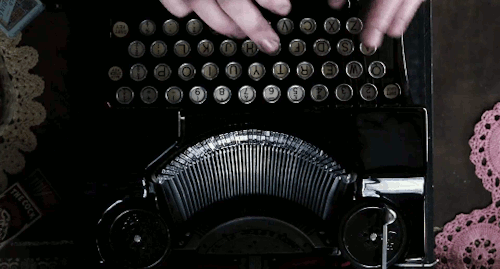
(this turned into a WALL OF TEXT so i will be using gifs to break it up)
> “I watched the ship tilt” “he saw the sky darken” “she noticed flowers growing on the rusted gate.” no. If the character who felt/saw/noticed etc is your POV character, whether in first or third, then this is called filtering and it takes the reader out of the story by subtly reminding them of the separation between the POV character and themselves. in most styles of writing, this is bad, not to mention it unnecessarily complicates your prose. try again: “the ship tilted.” “the sky darkened.” “flowers grew on the rusted gate.” Readers will instinctively understand that the POV character is witnessing the story happen, they don’t need to be told it.
I’m not telling you to never refer to your character “watching” something, of course: “I watched the birds dart around for hours,” isn’t filtering because watching is a notable activity, here, rather than an unnecessary obfuscation of the “real” thing happening. But understand how phrasing can jar readers momentarily apart from the character viewpoint, and use it with intention.
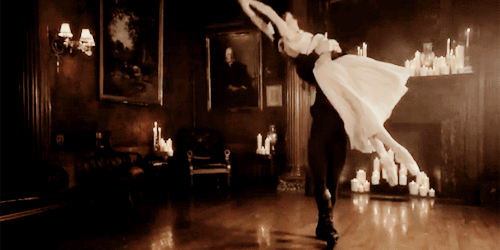
> Close Third Person POV still requires you to be mindful of your POV character. this is a rookie mistake i see allllllll the time. “Josh cried stupid tears at the beautiful display by the dancers,” is a sentence in Josh’s POV. “Stupid” tells us how he feels about the tears, “beautiful” tells us how he feels about the display. ok. all good so far. BUT.
“Josh cried stupid tears at the beautiful display by the dancers. It was everything he’d wanted from this production, from the lighting to the costumes to the exquisite choreography. Martha had to suppress a fond smile at his reaction; he was always so sweetly emotional after the curtain fell.”
Do you see what’s wrong with this paragraph? The first two sentences are Josh’s POV, and then the third one suddenly becomes Martha’s. A lot of amateur writers don’t even realize they’re doing this, which in its most egregious form is called “head-hopping,” but it’s disorienting and distracting for the reader, and makes it harder to connect with a single character. In multi-person close 3rd POV story, the POV should remain the same for an entire chapter (or at least, for an entire scene/ segment,) and change only between them. If you’re new to POV wrangling, watch your adjectives/ interiority (we’ll get to that in a second) and think “which character am I using as a lens right now, and am I being consistent" every once in a while until you get the hang of it.

> Related: let’s talk about interiority. Interiority is a more sophisticated way of thinking of a character’s “internal narration,” IE bits of prose whose job is not to advance the plot, set tone, or describe anything, (although it CAN do any of those things as well, and good prose will multitask) but to give us a specific sense of the character’s internal life, including backstory, likes, dislikes, fears, wants, and personality. In the above example paragraph, the middle sentence “It was everything he’d wanted from this production, from the lighting to the costumes to the exquisite choreography” Is interiority for Josh. It tells us that not only did he love the show, he’s very familiar with this art form and thus had expectations going in; likewise, listing the technical components is a way of emphasizing his enthusiasm while pointing out that it’s informed, implying that Josh himself is intellectually breaking down the performance even in appreciation.
“That’s a lot for a throwaway sentence you made up for an example.” Well, yeah, a little interiority goes a long way. Interiority is what creates the closeness we have to POV characters, the reason we understand them better than the non-POV characters they interact with. It’s particularly key in the first couple chapters of an original work, when we need to be sold on the character and understand the context they operate in.
If readers are having trouble connecting to or understanding the motivations of your character, you might need more interiority; if your story’s plot is agonizingly slow-moving (and you don’t want it to be) or your character is coming off as melodramatic, you might need less. It’s not something you should necessarily worry about; your amount of interiority in a WIP is probably fine, but being able to recognize it for what it is will help you be more mindful when you edit.
(Fanfic as a medium revels in interiority: that’s how you get 10k fics where nothing happens but two characters lying in bed talking and having Feelings. Or coffeeshop AUs that have literally no plot to speak of but are 100k+ long.)

> try not to describe the facial expression of a POV character, even in third person. rather like filtering, it turns us into a spectator of the character when they’re supposed to be our vessel, and since it’s *their* POV, there should be other ways available to communicate their emotion/ reactions. There are ways of circumventing this, (the example sentence where “Martha had to suppress a fond smile” is an example) where their expression is tied up in a physical action, or something done very deliberately by the character and therefore becomes something they would note to themselves, but generally, get rid of “[pov character’s] eye’s widened” and “[pov character] smiled.”
so that’s what i got! go forth and write with beautifully deliberate use of POV.
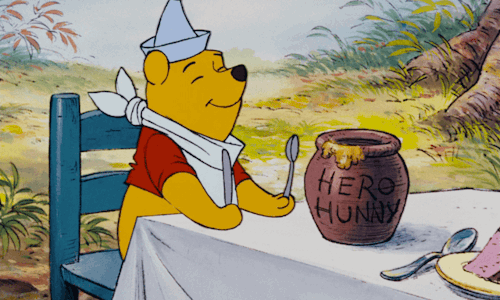
7K notes
·
View notes
